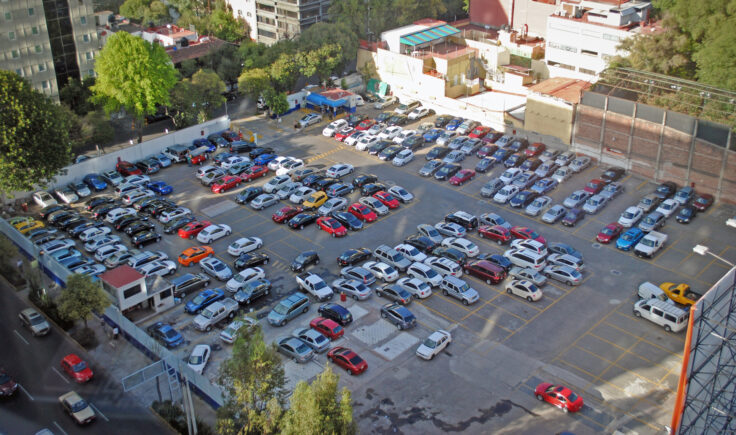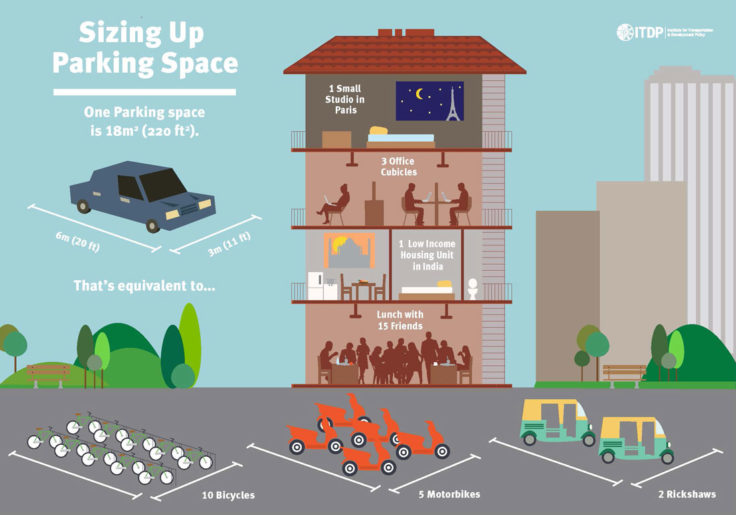September 12, 2023
Reforming Off-Street Parking is the Key to Fewer Emissions and More Livable Cities
In recent years, cities across the US and the world have been joining a growing movement to reshape urban infrastructure by rethinking parking policies. ITDP’s recent report on off-street parking is designed to provide insights on how to reform off-street parking based on lessons from diverse cities and countries worldwide.
Access ITDP’s “Breaking the Code” off-street parking report and view the related webinar.
On-street and off-street parking have been the subject of increasing public and political discourse in recent years as urban populations continue to grow and, with it, the urgent need for more affordable and available housing, green space, and access to employment and services. From New York City to Nairobi to Beijing, cities’ efforts to unravel outdated regulations related to the development of parking have certainly faced challenges, but are also beginning to yield successes. We know that the perpetual oversupply of parking in urban areas can lead directly to higher housing costs, inefficient land use, and more vehicle ownership and driving, which ultimately worsens air quality and increases emissions.
Thus, cities that continue to build new parking storage and maintain antiquated parking policies will continue to deal with critical environmental and social consequences. When looking at off-street parking in particular, it is important to understand the history of poor urban planning decisions and foresight that has perpetuated this abundance of underused parking garages and lots that are now pervasive in the cores of major cities everywhere. It began in the early 20th century in the US when, following the rapid rise in popularity and demand for motor vehicles, cities that were once primarily oriented toward streetcars and non-motorized transport modes sought to actively reshape their streets to cater to the automobile.

At the same time that automobiles became widely accessible, urban populations were growing, and suburban and peri-urban communities became a new standard for middle-class living. By the middle of the century, urban planners and policymakers in the US began to also prioritize highway development to ferry suburban car owners into city centers for work and leisure, making driving and vehicle storage a new focal point for city development. In the ensuing decades, in line with this surge in car ownership, policies across the US put parking minimums — or the requirement for all new developments to provide a minimum amount of vehicle storage — in place, creating a model that would soon be reproduced in cities around the world. We now recognize that parking minimum policies are largely arbitrary, tied to the number of seats in a restaurant or the square footage of retail space for example, and not informed by actual demand for parking at many of these destinations.
As a result, off-street parking mandates, and the resulting occupation of valuable city space with swaths of parking garages and surface lots, have contributed to pervasive issues of sustainability, housing availability, and social equity that plague our cities in the present day. Urban dwellers are caught in a cycle of competition for space and access to essential services, places to live, employment opportunities, healthcare, and other destinations — a cycle that mostly leaves those with fewer resources in the dust.
At the same time, large amounts of city land allocated to parking also sit underutilized and unproductive every day, spaces that we know can be used to house residents, generate economic activity, or provide much-needed urban greenery. Off-street parking is, unfortunately, a costly and often overlooked area of urban planning. Bringing parking supply closer to actual demand is crucial to creating a future for compact, accessible cities that are more livable and sustainable for everyone. It is important to note that the goal of off-street parking reform is not to eliminate parking altogether but to ensure that valuable urban space is used more efficiently and equitably.

In ITDP’s Breaking the Code: Off-Street Parking Reform report, we take a closer look at the considerations and potential outcomes of reforms by diving into the efforts of several cities and countries that have removed parking minimums and prioritized complementary actions. These case studies of Atlanta, GA, USA; Beijing, China; Mexico City, Mexico; Minneapolis, MN, USA; San Pedro Garza Garcia, Mexico; São Paulo, Brazil; and the country of New Zealand offer key lessons on real-world barriers and solutions that can serve as a guide for other governments and policymakers seeking to make similar changes to their policies. Informed by the experiences in the case studies, the report authors ultimately recommend that city, state, provincial, and national governments:
- Remove (or reduce) parking minimums;
- Leverage political will at the right level of government;
- Communicate plans for reform using messaging that resonates with the public;
- Collect and reference data to strengthen the “why” and “how”;
- Package parking reform alongside complementary policies; and
- Link parking reform to specific, achievable outcomes.

Removing parking minimums is an important first step to improving off-street parking so that fewer parking lots are built, encouraging more trips in and around cities to be made by sustainable modes like public transit, walking, and cycling. Related tools such as adopting parking maximums – limiting how much parking space can actually be built — and reducing the street frontage of surface lots and garages can deliver even more impact.
The removal of parking minimums is often even considered favorable by local businesses and property developers, whose costs can be significantly reduced when requirements to provide parking and reallocate space are removed. City space that would have been previously required for parking and vehicle storage can subsequently be used for the development of new housing units, retail, healthcare facilities, parks, and beyond — efforts that will undoubtedly garner public, political, and economic support.
As governments work to rethink outdated parking minimums, impose new maximums, and improve street space management, we look forward to having more models and evidence from major cities to show that reform is both necessary and urgent for the future of our cities.
Find more of ITDP’s parking reform resources here.
